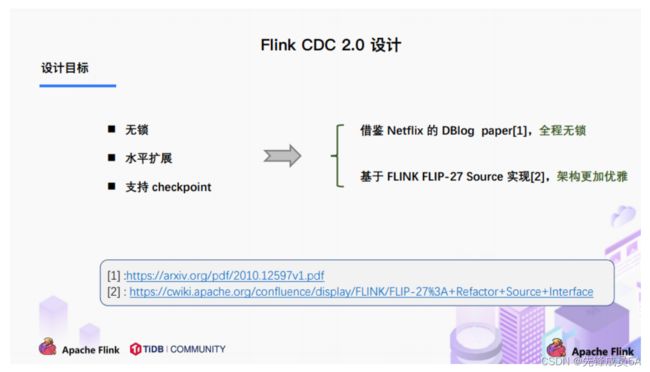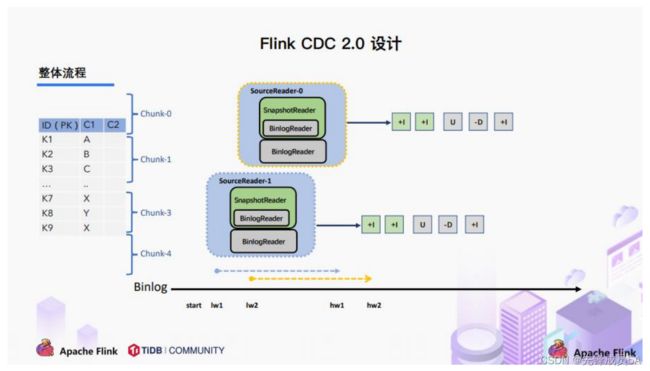flink扩展-1、Flink-CDC
一、CDC 简介
1.1 什么是CDC
CDC 是 Change Data Capture(变更数据获取)的简称。核心思想是,监测并捕获数据库的变动(包括数
据或数据表的插入、更新以及删除等),将这些变更按发生的顺序完整记录下来,写入到消息中间件中以供其他服
务进行订阅及消费。
1.2 CDC的种类
CDC 主要分为基于查询和基于 Binlog 两种方式,我们主要了解一下这两种之间的区别:
1.3 Flink-CDC
Flink 社区开发了 flink-cdc-connectors 组件,这是一个可以直接从 MySQL、PostgreSQL 等数据库直接读
取全量数据和增量变更数据的 source 组件。
目前也已开源,开源地址:GitHub - ververica/flink-cdc-connectors: CDC Connectors for Apache Flink®
二、Flink CDC案例实操
2.1 DataStream方式的应用
2.1.1 导入依赖
org.apache.flink flink-java 1.12.0 org.apache.flink flink-streaming-java_2.12 1.12.0 org.apache.flink flink-clients_2.12 1.12.0 org.apache.hadoop hadoop-client 3.1.3 mysql mysql-connector-java 5.1.49 org.apache.flink flink-table-planner-blink_2.12 1.12.0 com.ververica flink-connector-mysql-cdc 2.0.0 com.alibaba fastjson 1.2.75 org.apache.maven.plugins maven-assembly-plugin 3.0.0 jar-with-dependencies make-assembly package single
2.1.2 编写代码
import com.alibaba.ververica.cdc.connectors.mysql.MySQLSource;
import com.alibaba.ververica.cdc.debezium.DebeziumSourceFunction;
import com.alibaba.ververica.cdc.debezium.StringDebeziumDeserializationSchema;
import org.apache.flink.api.common.restartstrategy.RestartStrategies;
import org.apache.flink.runtime.state.filesystem.FsStateBackend;
import org.apache.flink.streaming.api.CheckpointingMode;
import org.apache.flink.streaming.api.datastream.DataStreamSource;
import org.apache.flink.streaming.api.environment.CheckpointConfig;
import org.apache.flink.streaming.api.environment.StreamExecutionEnvironment;
import java.util.Properties;
public class FlinkCDC {
public static void main(String[] args) throws Exception {
// 1.创建执行环境
StreamExecutionEnvironment env = StreamExecutionEnvironment.getExecutionEnvironment();
env.setParallelism(1);
// 2.Flink-CDC 将读取 binlog 的位置信息以状态的方式保存在 CK,如果想要做到断点续传,需要从 Checkpoint 或者
// Savepoint 启动程序
// 2.1 开启 Checkpoint,每隔 5 秒钟做一次 CK
env.enableCheckpointing(5000L);
// 2.2 指定 CK 的一致性语义
env.getCheckpointConfig().setCheckpointingMode(CheckpointingMode.EXACTLY_ONCE);
// 2.3 设置任务关闭的时候保留最后一次 CK 数据
env.getCheckpointConfig()
.enableExternalizedCheckpoints(CheckpointConfig.ExternalizedCheckpointCleanup.RETAIN_ON_CANCELLATION);
// 2.4 指定从 CK 自动重启策略
env.setRestartStrategy(RestartStrategies.fixedDelayRestart(3, 2000L));
// 2.5 设置状态后端
env.setStateBackend(new FsStateBackend("hdfs://hadoop102:8020/flinkCDC"));
// 2.6 设置访问 HDFS 的用户名
System.setProperty("HADOOP_USER_NAME", "wyb");
// 3.创建 Flink-MySQL-CDC 的 Source
// initial (default): Performs an initial snapshot on the monitored database
// tables upon
//first startup, and continue to read the latest binlog.
// latest-offset: Never to perform snapshot on the monitored database tables
// upon first
//startup, just read from the end of the binlog which means only have the changes since the
//connector was started.
// timestamp: Never to perform snapshot on the monitored database tables upon
// first
//startup, and directly read binlog from the specified timestamp. The consumer will traverse the
//binlog from the beginning and ignore change events whose timestamp is smaller than the
//specified timestamp.
// specific-offset: Never to perform snapshot on the monitored database tables
// upon
//first startup, and directly read binlog from the specified offset.
DebeziumSourceFunction mysqlSource = MySQLSource.builder().hostname("hadoop102").port(3306)
.username("root").password("000000").databaseList("gmall-flink").tableList("gmall-flink.z_user_info") // 可选配置项,如果不指定该参数,则会读取上一个配置下的所有表的数据,注意:指定的时候需要使用"db.table"的方式
.startupOptions(StartupOptions.initial()).deserializer(new StringDebeziumDeserializationSchema())
.build();
// 4.使用 CDC Source 从 MySQL 读取数据
DataStreamSource mysqlDS = env.addSource(mysqlSource);
// 5.打印数据
mysqlDS.print();
// 6.执行任务
env.execute();
}
}
2.1.3 案例测试
1)打包并上传至 Linux
2)开启 MySQL Binlog 并重启 MySQL
3)启动 Flink 集群
[wyb@hadoop102 flink-standalone]$ bin/start-cluster.sh
4)启动 HDFS 集群
[wyb@hadoop102 flink-standalone]$ start-dfs.sh
5)启动程序
[wyb@hadoop102 flink-standalone]$ bin/flink run -c com.wyb.FlinkCDC flink-1.0-
SNAPSHOT-jar-with-dependencies.jar
6)在 MySQL 的 gmall-flink.z_user_info 表中添加、修改或者删除数据
7)给当前的 Flink 程序创建 Savepoint
[wyb@hadoop102 flink-standalone]$ bin/flink savepoint JobId
hdfs://hadoop102:8020/flink/save
8)关闭程序以后从 Savepoint 重启程序
[wyb@hadoop102 flink-standalone]$ bin/flink run -s hdfs://hadoop102:8020/flink/save/... -c
com.wyb.FlinkCDC flink-1.0-SNAPSHOT-jar-with-dependencies.jar
2.2 FlinkSQL方式的应用
2.2.1代码实现
import org.apache.flink.api.common.restartstrategy.RestartStrategies;
import org.apache.flink.runtime.state.filesystem.FsStateBackend;
import org.apache.flink.streaming.api.CheckpointingMode;
import org.apache.flink.streaming.api.environment.CheckpointConfig;
import org.apache.flink.streaming.api.environment.StreamExecutionEnvironment;
import org.apache.flink.table.api.bridge.java.StreamTableEnvironment;
public class FlinkSQL_CDC {
public static void main(String[] args) throws Exception {
// 1.创建执行环境
StreamExecutionEnvironment env = StreamExecutionEnvironment.getExecutionEnvironment();
env.setParallelism(1);
StreamTableEnvironment tableEnv = StreamTableEnvironment.create(env);
// 2.创建 Flink-MySQL-CDC 的 Source
tableEnv.executeSql("CREATE TABLE user_info ("
+ " id INT,"
+ " name STRING,"
+ " phone_num STRING" + ") WITH ("
+ " 'connector' = 'mysql-cdc',"
+ " 'hostname' = 'hadoop102',"
+ " 'port' = '3306',"
+ " 'username' = 'root',"
+ " 'password' = '000000',"
+ " 'database-name' = 'gmall-flink',"
+ " 'table-name' = 'z_user_info'" + ")");
tableEnv.executeSql("select * from user_info").print();
env.execute();
}
}
2.3自定义反序列化器
2.3.1 代码实现
import com.alibaba.fastjson.JSONObject;
import com.alibaba.ververica.cdc.connectors.mysql.MySQLSource;
import com.alibaba.ververica.cdc.debezium.DebeziumDeserializationSchema;
import com.alibaba.ververica.cdc.debezium.DebeziumSourceFunction;
import io.debezium.data.Envelope;
import org.apache.flink.api.common.restartstrategy.RestartStrategies;
import org.apache.flink.api.common.typeinfo.TypeInformation;
import org.apache.flink.runtime.state.filesystem.FsStateBackend;
import org.apache.flink.streaming.api.CheckpointingMode;
import org.apache.flink.streaming.api.datastream.DataStreamSource;
import org.apache.flink.streaming.api.environment.CheckpointConfig;
import org.apache.flink.streaming.api.environment.StreamExecutionEnvironment;
import org.apache.flink.util.Collector;
import org.apache.kafka.connect.data.Field;
import org.apache.kafka.connect.data.Struct;
import org.apache.kafka.connect.source.SourceRecord;
import java.util.Properties;
public class Flink_CDCWithCustomerSchema {
public static void main(String[] args) throws Exception {
//1.创建执行环境
StreamExecutionEnvironment env = StreamExecutionEnvironment.getExecutionEnvironment();
env.setParallelism(1);
//2.创建 Flink-MySQL-CDC 的 Source
DebeziumSourceFunction mysqlSource = MySQLSource.builder()
.hostname("hadoop102")
.port(3306)
.username("root")
.password("000000")
.databaseList("gmall-flink")
.tableList("gmall-flink.z_user_info") //可选配置项,如果不指定该
参数,则会读取上一个配置下的所有表的数据,注意:指定的时候需要使用"db.table"的方式
.startupOptions(StartupOptions.initial())
.deserializer(new DebeziumDeserializationSchema() { //自定义数据解析器
@Override
public void deserialize(SourceRecord sourceRecord, Collector collector) throws Exception {
//获取主题信息,包含着数据库和表名
mysql_binlog_source.gmall-flink.z_user_info
String topic = sourceRecord.topic();
String[] arr = topic.split("\\.");
String db = arr[1];
String tableName = arr[2];
//获取操作类型 READ DELETE UPDATE CREATE
Envelope.Operation operation =
Envelope.operationFor(sourceRecord);
//获取值信息并转换为 Struct 类型
Struct value = (Struct) sourceRecord.value();
//获取变化后的数据
Struct after = value.getStruct("after");
//创建 JSON 对象用于存储数据信息
JSONObject data = new JSONObject();
for (Field field : after.schema().fields()) {
Object o = after.get(field);
data.put(field.name(), o);
}
//创建 JSON 对象用于封装最终返回值数据信息
JSONObject result = new JSONObject();
result.put("operation", operation.toString().toLowerCase());
result.put("data", data);
result.put("database", db);
result.put("table", tableName);
//发送数据至下游
collector.collect(result.toJSONString());
}
@Override
public TypeInformation getProducedType() {
return TypeInformation.of(String.class);
}
})
.build();
//3.使用 CDC Source 从 MySQL 读取数据
DataStreamSource mysqlDS = env.addSource(mysqlSource);
//4.打印数据
mysqlDS.print();
//5.执行任务
env.execute();
}
}
三、Flink-CDC 2.0
本章图片来源于北京站 Flink Meetup 分享的《详解 Flink-CDC》
3.1 flink cdc 1.x痛点
3.2设计目标
3.3设计实现
3.3.1整体概览
在对于有主键的表做初始化模式,整体的流程主要分为 5 个阶段:
1.Chunk 切分;2.Chunk 分配;(实现并行读取数据&CheckPoint)
3.Chunk 读取;(实现无锁读取)
4.Chunk 汇报;
5.Chunk 分配。
3.3.2 Chunk 切分
根据 Netflix DBlog 的论文中的无锁算法原理,对于目标表按照主键进行数据分片,设置
每个切片的区间为左闭右开或者左开右闭来保证数据的连续性。
3.3.3 Chunk分配
将划分好的 Chunk 分发给多个 SourceReader,每个 SourceReader 读取表中的一部分数据,实现了并行读
取的目标。
同时在每个 Chunk 读取的时候可以单独做 CheckPoint,某个 Chunk 读取失败只需要单独执行该 Chunk 的
任务,而不需要像 1.x 中失败了只能从头读取。
若每个 SourceReader 保证了数据一致性,则全表就保证了数据一致性。
3.3.4 Chunk读取
读取可以分为 5 个阶段
1)SourceReader 读取表数据之前先记录当前的 Binlog 位置信息记为低位点;
2)SourceReader 将自身区间内的数据查询出来并放置在 buffer 中;
3)查询完成之后记录当前的 Binlog 位置信息记为高位点;
4)在增量部分消费从低位点到高位点的 Binlog;
5)根据主键,对 buffer 中的数据进行修正并输出。
通过以上5个阶段可以保证每个Chunk最终的输出就是在高位点时该Chunk中最新的数据,
但是目前只是做到了保证单个 Chunk 中的数据一致性。
3.3.5 Chunk汇报
在 Snapshot Chunk 读取完成之后,有一个汇报的流程,如上图所示,即 SourceReader 需要将 Snapshot
Chunk 完成信息汇报给 SourceEnumerator。
3.3.6 Chunk分配
FlinkCDC 是支持全量+增量数据同步的,在 SourceEnumerator 接收到所有的 Snapshot
Chunk 完成信息之后,还有一个消费增量数据(Binlog)的任务,此时是通过下发 Binlog Chunk
给任意一个 SourceReader 进行单并发读取来实现的。
3.4核心原理分析
3.4.1 Binlog Chunk中开始读取位置源码
MySqlHybridSplitAssigner
private MySqlBinlogSplit createBinlogSplit() {
final List assignedSnapshotSplit = snapshotSplitAssigner
.getAssignedSplits().values().stream()
.sorted(Comparator.comparing(MySqlSplit::splitId))
.collect(Collectors.toList());
Map splitFinishedOffsets = snapshotSplitAssigner.getSplitFinishedOffsets();
final List finishedSnapshotSplitInfos = new ArrayList<>();
final Map tableSchemas = new HashMap<>();
BinlogOffset minBinlogOffset = BinlogOffset.INITIAL_OFFSET;
for (MySqlSnapshotSplit split : assignedSnapshotSplit) {
// find the min binlog offset
BinlogOffset binlogOffset = splitFinishedOffsets.get(split.splitId());
if (binlogOffset.compareTo(minBinlogOffset) < 0) {
minBinlogOffset = binlogOffset;
}
finishedSnapshotSplitInfos.add(
new FinishedSnapshotSplitInfo(
split.getTableId(),
split.splitId(),
split.getSplitStart(),
split.getSplitEnd(),
binlogOffset));
tableSchemas.putAll(split.getTableSchemas());
}
final MySqlSnapshotSplit lastSnapshotSplit = assignedSnapshotSplit.get(assignedSnapshotSplit.size() - 1).asSnapshotSplit();
return new MySqlBinlogSplit(BINLOG_SPLIT_ID,
lastSnapshotSplit.getSplitKeyType(),minBinlogOffset,BinlogOffset.NO_STOPPING_OFFSET,finishedSnapshotSplitInfos,tableSchemas);
}
3.4.2读取低位点到高位点之间的Binlog
BinlogSplitReader
/** * Returns the record should emit or not. * *The watermark signal algorithm is the binlog split reader only sends the binlog event that * belongs to its finished snapshot splits. For each snapshot split, the binlog event is valid * since the offset is after its high watermark. * *
E.g: the data input is : * snapshot-split-0 info : [0, 1024) highWatermark0 * snapshot-split-1 info : [1024, 2048) highWatermark1 * the data output is: * only the binlog event belong to [0, 1024) and offset is after highWatermark0 should send, * only the binlog event belong to [1024, 2048) and offset is after highWatermark1 should send. **/ private boolean shouldEmit(SourceRecord sourceRecord) { if (isDataChangeRecord(sourceRecord)) { TableId tableId = getTableId(sourceRecord); BinlogOffset position = getBinlogPosition(sourceRecord); // aligned, all snapshot splits of the table has reached max highWatermark if (position.isAtOrBefore(maxSplitHighWatermarkMap.get(tableId))) { return true; } Object[] key = getSplitKey( currentBinlogSplit.getSplitKeyType(),sourceRecord, statefulTaskContext.getSchemaNameAdjuster()); for (FinishedSnapshotSplitInfo splitInfo : finishedSplitsInfo.get(tableId)) { if (RecordUtils.splitKeyRangeContains(key, splitInfo.getSplitStart(), splitInfo.getSplitEnd()) && position.isAtOrBefore(splitInfo.getHighWatermark())) { return true; } } // not in the monitored splits scope, do not emit return false; } // always send the schema change event and signal event // we need record them to state of Flink return true; }









